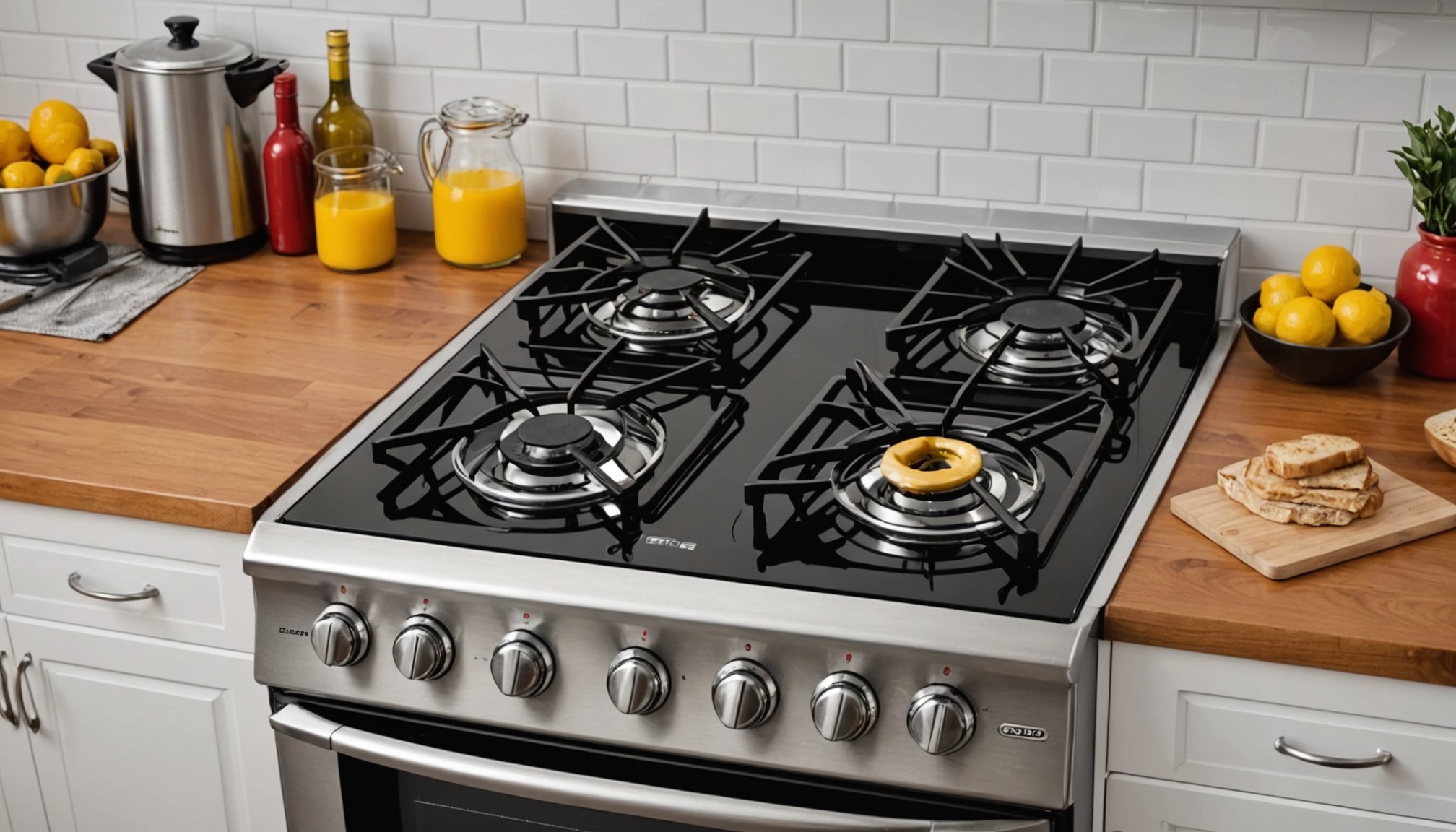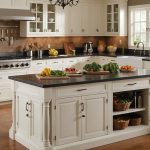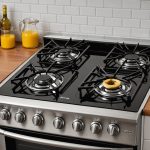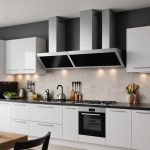Importance of Proper Installation of a Gas Stove
Gas stove installation safety is critical to ensure both safe and efficient operation. Improper installation can lead to gas leaks, fire hazards, and even carbon monoxide poisoning. Adhering to safety standards, particularly in compact kitchens, is not only beneficial but necessary. Compact kitchen guidelines are designed to help you manoeuvre within limited spaces safely, ensuring that every appliance, including gas stoves, is installed with precision.
Following these guidelines is crucial because compact kitchens often have less room for error. For instance, small clearances can impede proper ventilation, exacerbating risks associated with gas buildup. Safety standards include recommendations for appliance placement, ventilation paths, and even materials used in the kitchen to reduce the possibility of accidents.
Topic to read : Key considerations for installing a water softener in your uk kitchen: a comprehensive guide
Lastly, it is vital to adhere to local building codes. These codes are designed to protect occupants by enforcing safe practices, often stipulating specifics like minimum distances from flammable materials or mandatory equipment, such as exhaust hoods. Compliance not only promises a safer kitchen environment but also avoids legal pitfalls or penalties. Proper installation, therefore, becomes an act of both safety and due diligence.
Ventilation Requirements for Gas Stoves
Gas stove ventilation is essential for maintaining kitchen air quality by preventing gas buildup. In confined spaces, proper ventilation not only ensures safety but also optimises the performance of your gas stove. The role of ventilation is to dissipate harmful gases and greasy fumes generated during cooking.
Have you seen this : Ultimate guide to the best thermal insulation options for kitchen flooring in the uk”s colder areas
When it comes to ventilation systems, range hoods are highly recommended. They come in various options, such as ducted and ductless hoods. Ducted range hoods are effective as they expel air outside, reducing indoor pollution levels significantly. Ductless hoods, meanwhile, filter air and recirculate it, which can suffice provided they are regularly maintained.
Specifications for these systems vary, but an efficient system should exchange kitchen air at a minimum of 100 cubic feet per minute (CFM). The effectiveness of a system relies heavily on regular maintenance. Filters should be cleaned or replaced and fans inspected routinely to ensure optimal performance.
Regular checks are crucial to prevent obstructions that can reduce efficiency and compromise your kitchen air quality. By understanding and implementing these ventilation requirements, you uphold both the safety and functionality of your cooking environment.
Clearance and Space Considerations
Maximising compact kitchen space planning goes hand-in-hand with ensuring gas stove clearance requirements are met. It is crucial to maintain a minimum clearance from surrounding walls and overhead cabinets to prevent heat buildup and potential fire risks. Typical installations require at least 12 inches of clearance on each side of the stove and 24 inches above, though specifics can vary based on models and local guidelines.
Careful measurement and planning are essential in small kitchens. Consider the layout to effectively utilise every inch without compromising safety. Use retractable or foldable furniture and appliances when possible to free up space, creating a more open and flexible cooking area.
Adopting smart design choices in compact setups can enhance both aesthetics and functionality. For example, installing vertical storage solutions can keep items within reach but away from immediate heat zones. Additionally, opting for streamlined appliances helps in maintaining both clearance guidelines and a clutter-free environment.
Incorporating these strategies while adhering to clearance requirements ensures a safe and efficient kitchen space. Embrace innovative design and practical solutions to maximise your compact kitchen’s potential without sacrificing safety.
Common Installation Errors to Avoid
When installing a gas stove, awareness of potential gas stove installation pitfalls is crucial. Avoiding these frequent mistakes ensures both safety and efficiency. One common error is failing to secure connections properly, leading to leaks. Always ensure gas fittings are tightly sealed, and double-check with soapy water to detect any leaks.
Another pitfall is improper appliance placement. Ensure adequate space around the stove to prevent overheating and fire hazards. Installing the stove too close to combustible materials is especially dangerous, emphasizing the importance of respecting clearance guidelines.
Incorrectly installed ventilation systems can also result in poor kitchen air quality. Verify that ducts and vents are free from obstructions to enable effective pollutant extraction.
Watch for signs of incorrect installation, such as unusual gas odours, uneven flames, or pilot issues. Listening for hissing sounds can also indicate a leak.
If you encounter any of these issues, immediately consult a certified professional to assess and address the problem. Following best practices and troubleshooting effectively mitigates the risks associated with gas stove installations, keeping your kitchen safe.
Gas Line Installation Guidelines
Proper gas line installation is paramount to ensuring the safe operation of your stove. Incorrect connections can lead to severe risks, including leaks and potential explosions. To start, expertise in handling gas lines is non-negotiable. It is imperative to enlist certified professionals for this task, as they have the necessary skills and knowledge to adhere to safety protocols.
The first step involves identifying the correct gas source and ensuring it is compatible with your stove. Certified professionals will then execute precise connections using appropriate fittings and seals to prevent leaks. After the initial setup, conducting thorough gas leak tests is a must. Use soapy water on connections to spot leaks—bubbles forming indicate potential leaks.
Conducting pressure tests adds another layer of safety. These tests help identify weaknesses in the setup and ensure the system can handle the standard gas pressure without issue. For peace of mind, have your gas line regularly checked by professionals even post-installation.
By prioritising professional installation and regular testing, you bridge the gap between safety and efficient gas stove operation, safeguarding your home environment.
Maintenance and Safety Checks
Regular stove maintenance and gas stove safety checks are crucial for smooth operation and longevity. To start, frequent cleaning of burners and grates prevents residue buildup, which can compromise efficiency. Similarly, routine checks of knobs and connections discourage undetected wear and tear that may lead to gas leaks.
When conducting a safety check, focus on these areas:
- Visual Inspection: Look for signs of wear, unusual odours, or visible damage to components.
- Functionality Test: Ensure all burners ignite uniformly and maintain steady, blue flames, indicating proper combustion.
- Gas Leak Detection: Use soapy water on exposed connections; bubbles form if a leak exists.
For a more thorough assessment, consider scheduling regular professional inspections. Certified technicians possess the tools and expertise to identify potential issues that may be overlooked during general maintenance.
Additionally, maintain an emergency plan. Know how to shut off the gas supply and contact emergency services if necessary. Resources such as manufacturer manuals provide detailed guidance and safety advice, ensuring your gas stove remains compliant with safety standards and operational needs. Prioritising these checks not only enhances safety but also offers peace of mind.
Relevant Regulations and Resources
Understanding relevant gas stove regulations is crucial for ensuring a safe and compliant installation. Both local and national regulations govern the process, detailing requirements related to safety standards, clearance specifications, ventilation systems, and gas line connections.
Local building codes serve as a primary reference. These regulations often stipulate minimum clearance from flammable materials, ensuring ample space around the stove to prevent overheating. Adherence to compact kitchen guidelines ensures that safety is not compromised, even when space is limited.
National standards demand certain specifications for gas stoves, including the thickness of piping and the type of ventilation systems used. Familiarising yourself with these rules is vital, especially in compact kitchen settings where improper installation can increase risks.
To facilitate compliance, consult installation resources such as the owner’s manual provided by the stove manufacturer. Additionally, governmental and local council websites can be invaluable for obtaining necessary permits and scheduling inspections.
Finding licensed professionals is key to navigating these requirements efficiently. Certified installers are knowledgeable about gas stove regulations, ensuring both safety and peace of mind. Prioritising professional guidance will ensure both adherence to codes and a safer living environment.











